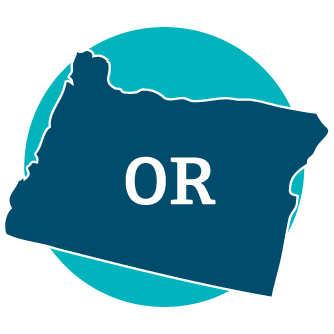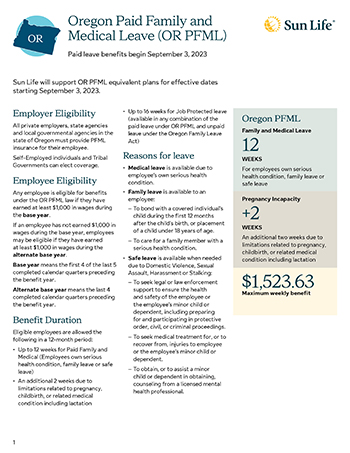If you are not a broker or consultant, explore our content for plan members and families, employers, or dentists and dental offices.
Sun Life is eager to meet your Oregon Paid Family and Medical Leave (OR PFML) needs for equivalent plan administration. Sun Life’s OR PFML plan integrates with its Short-Term Disability plans, featuring one claim submission, one claim number, one case manager, and integrated reporting for employers.
Sun Life has created this website for employers and brokers to help comply with responsibilities under the OR PFML law. Please visit this site often for updates.
Additionally, the State of Oregon Employment Department is the agency responsible for administering the OR PFML law. Information from the Employment Department about equivalent plans can be found on the Paid Leave Oregon website.
Quick Facts
Key Dates
- January 1, 2023 – Employers who do not have an approved equivalent plan exemption start collecting employee contributions, (if desired)
- May 31,2023 – last day to submit an equivalent plan application through Francis Online for a plan effective September 3, 2023, and to be exempt from submitting 3rd quarter premium to the state
- September 3, 2023 – Benefits start
Benefit Duration
- 12 weeks of paid leave per benefit year
- Additional 2 weeks for limitations related to pregnancy
Reasons for Leave
- Family Leave – to care for a family member with a serious health condition, or to bond with a new child after birth, adoption or foster care placement
- Medical Leave – for one’s own serious health condition
- Safe Leave – for one’s own, or their minor child’s, recovery after sexual assault, domestic violence, harassment, a bias crime, or stalking
Maximum Weekly Benefit
- $1,568.60
Frequently Asked Questions
Sun Life is committed to assisting you in complying with the requirements of the new OR PFML law and with providing valuable employee benefits to your employees. We also offer leave and accommodations administration services. Please reach out to us and we will evaluate your benefit plans and compliance needs from a holistic perspective and provide guidance and services to meet you and your employees’ needs.
Content is subject to change as Sun Life receives guidance from states and municipalities. This content is not to be considered legal advice. We recommend Clients speak with legal counsel specializing in labor and employment law to ensure your organization has met all of the requirements under the Oregon Paid Family & Medical Leave (PFML) Act, and other applicable leave laws including but not limited to the federal FMLA and the Oregon Family Leave Act. When available, Sun Life’s fully insured OR PFML coverage, subject to regulatory approval, will be issued by Sun Life Assurance Company of Canada (Wellesley Hills, MA). Sun Life’s self-funded or administrative-services-only OR PFML solution will be administered by Sun Life Assurance Company of Canada (Wellesley Hills, MA). This service is not insurance.
© 2022 Sun Life Assurance Company of Canada, Wellesley Hills, MA 02481. All rights reserved. The Sun Life name and logo are trademarks of Sun Life Assurance Company of Canada. Visit us at www.sunlife.com/us.
PFMLWC-918
SLPC 31728 08/22 (exp. 08/24)


